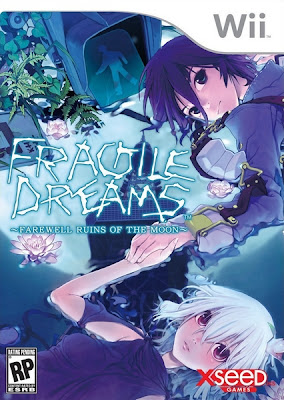A Look at Fragile Dreams: Farewell Ruins of the Moon
I may be a devoted geek, but I'm also a cheap geek. Thus, when Nintendo announced that they'll be winding down their support of the Wii to work on their upcoming Wii U, I was kind of happy because that meant that the prices for Wii games will drop to my level of penny-pinching. Among the Wii games that I have purchased during the recent price drops has been Fragile Dreams: Farewell Ruins of the Moon
I didn't know what to expect from this game, but I heard enough positive things about it to encourage my purchase of it. Now that I've finished playing it, I can say that Fragile Dreams is one of the best games made for the Wii, as well as the most spellbinding game I have seen in a long time. Read on for my complete review of this unfairly overlooked Wii gem from 2010.
Fragile Dreams takes place in Japan over a decade after some unknown catastrophe had wiped out almost the entire human race. The main character is Seto, a 15 year old boy who was raised by an old man who he refers to as his grandfather in a small observatory. The game begins shortly after the old man passes away, and Seto decides to leave the observatory to search for other survivors in the ruins of Tokyo. Early in his travels, he briefly encounters a mysterious silver-haired girl; Seto's search for this girl becomes the game's central quest, with Seto encountering a peculiar array of characters, ghosts, monsters and artifacts along the way and learning more about what almost drove the human race into extinction. Ultimately, Fragile Dreams uses its story and game play to engage in a meditation on loneliness and companionship.
In many ways, Fragile Dreams is the equal and opposite of Konami's Silent Hill: Shattered Memories
For as scary and morbid as the game sounds (and it does get very scary and morbid in quite a few places), Fragile Dreams presents itself as a dark yet whimsical fairy tale, a mash-up of sorts of Sleeping Beauty
Mixing seamlessly into Fragile Dream's vibrant visual style is its engaging usage of Wii's motion controls. The game requires that you use the nunchuck to move Seto and the Wiimote to move Seto's flashlight and aim his weapons, but that's just the beginning. The game uses the speakers within the Wiimote to provide certain audio cues that indicate where particular characters are located. You also need the Wiimote to find helpful messages and mystery items that are hidden throughout each location you explore. Each item you examine has a story to tell, since they maintain the memories of their long dead owners and in turn add to the narrative richness of Fragile Dreams. Some of the stories recall how individuals dealt with the impending doom that nearly destroyed humanity, while others provide a few clues as to what went wrong to cause such destruction.
For as impressive as Fragile Dreams is, it does have its drawbacks. Some of its challenges not very intuitive, so I had to look up a walkthrough guide to understand what I had to do next to make it through certain boss battles. The game also has a troublesome inventory access scheme. Seto carries his inventory of supplies (weapons, artifacts, food and health kits) in his small backpack and in his large briefcase. He can access the supplies in his backpack at any time, but he can only access the briefcase at game save points, which are represented by small campfires. Even though there are enough campfires scattered throughout the game, it can be especially frustrating when your available weapons break or you run out of available health kits during a monster fight and you cannot get back to a campfire to access the supplies stored in Seto's briefcase.
Between its amazing visuals, elegant soundtrack and poignant story, Fragile Dreams is a unique and unforgettable video game experience. It's not for everybody (die-hard fans of high-intensity action games should look elsewhere), but I highly recommend it for those who like stylish, story-driven games that take place in mysterious worlds that are waiting to be explored. With the price of this game currently set at around $20, now is a perfect time to add it to your Wii collection.







Comments
Post a Comment